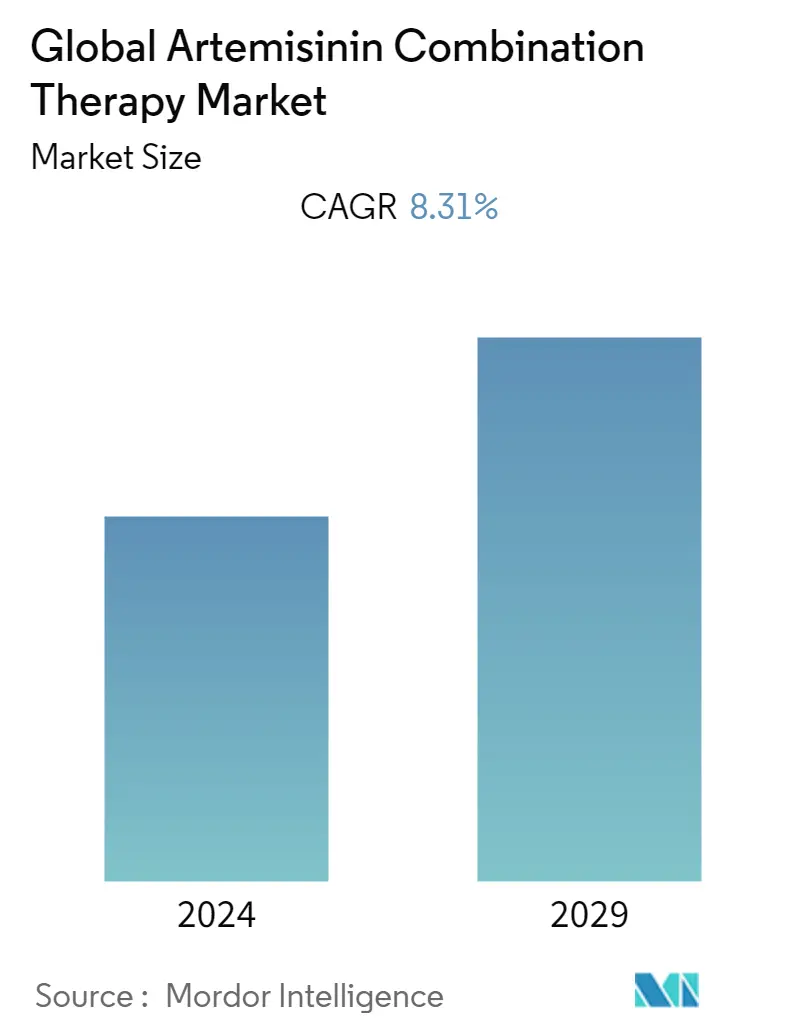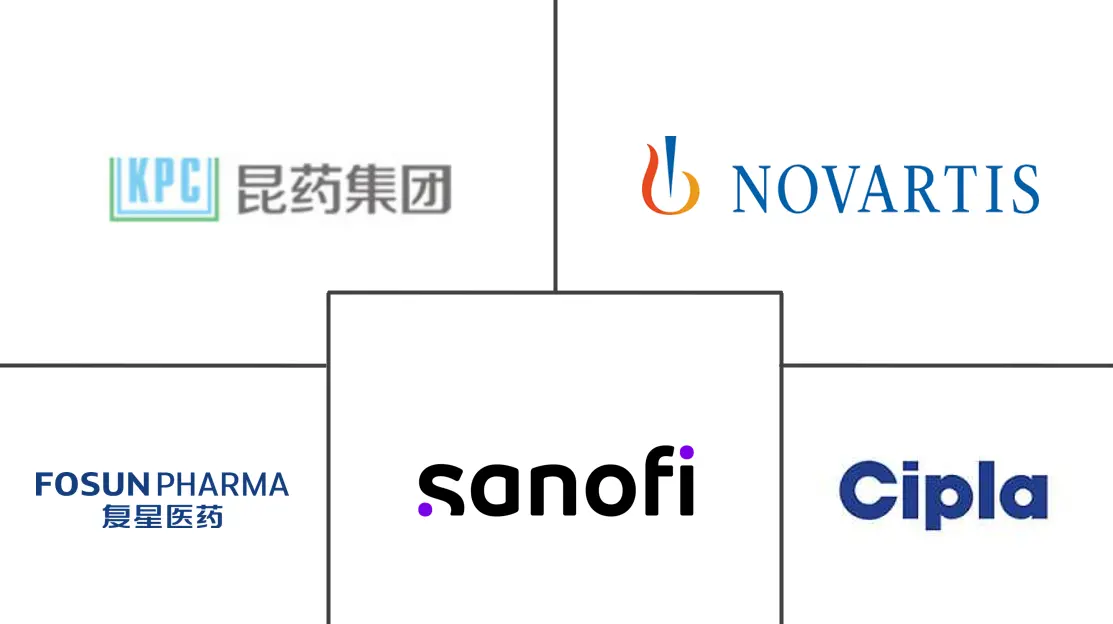Market Size of Global Artemisinin Combination Therapy Industry

| Study Period | 2021 - 2029 |
| Base Year For Estimation | 2023 |
| CAGR | 8.31 % |
| Fastest Growing Market | Asia Pacific |
| Largest Market | North America |
| Market Concentration | Medium |
Major Players
*Disclaimer: Major Players sorted in no particular order |
Artemisinin Combination Therapy Market Analysis
Over the next few years, the market for artemisinin combination therapy is expected to grow at a CAGR of 8.31%.
The COVID-19 pandemic had a significant impact on the artemisinin combination therapy market. For instance, an article published by the National Center for Biotechnology Information (NCBI) in October 2021 reported that children and pregnant women were bearing a disproportionate burden of excess malaria mortality arising from COVID-19-related disruption of health systems and malaria control programs, particularly in sub-Saharan Africa. This was primarily because the COVID-19 pandemic was disrupting malaria diagnosis, as both diseases share some symptoms. It is because of these factors that the artemisinin combination therapy market was expected to be affected during the COVID-19 pandemic. In the current scenario, due to the availability of better diagnoses and vaccines for COVID-19 treatment, the artemisinin combination therapy may be used for malaria treatment, and the market is expected to witness significant growth over the forecast period.
The studied market is growing because there is a lot of malaria in developing and underdeveloped countries, governments are trying to raise awareness, and more research is being done to find new drugs and new ways to use old ones.For instance, the data published by the World Malaria Report in 2022 reported that the following regions showed an increase in malaria cases in 2021: Comoros (56.9%), Costa Rica (52.4%), the Democratic People's Republic of Korea (22.8%), Ecuador (11.1%), Eswatini (53.9%), French Guyana (2.1%), Guatemala (16.9%), Honduras (47.4%), Panama (55.3%), and Sao Tome and Principe (28.9%). According to the source, the number of malaria-endemic countries with fewer than 1000 indigenous malaria cases increased from 33 in 2020 to 35 in 2021.Thus, a high number of malaria cases is driving the growth of the studied market.
Additionally, awareness programs and other government initiatives are other factors that propel market growth. For instance, in July 2022, the Ministry of Health and Family Welfare of India launched Jan Abhiyaans with log bhagidari (people's participation) to enthuse and engage citizens and communities to ensure that their homes, premises, and neighborhoods are free of mosquitoes. Similarly, in July 2021, WHO launched the E-2025 initiative to support 25 countries and one territory identified as having the capacity to eliminate malaria by 2025. Thus, such initiatives are likely to increase market growth.
Furthermore, clinical trials for the introduction of new drugs are propelling the growth of the studied market.For instance, in November 2022, Novartis and Medicines for Malaria Venture (MMV) reported plans to advance a ganaplacide/lumefantrine solid dispersion formulation (SDF) into a Phase III clinical trial to treat individuals with acute, uncomplicated malaria caused by Plasmodium falciparum. Thus, such studies are contributing to the studied market's growth.
Thus, due to the high prevalence of malaria in developing and underdeveloped countries, awareness initiatives undertaken by the governments, and increasing research for new drugs and new combination therapies, the market is expected to witness significant growth over the forecast period. However, the side effects of antimalarial drugs and the presence of counterfeit and substandard drugs are restraining the growth of this market.
Artemisinin Combination Therapy Industry Segmentation
As per the scope of the report, artemisinin is a plant derivative isolated from artemisia annua, or sweet wormwood, which is known to effectively and swiftly reduce the number of plasmodium parasites in the blood of malaria patients. The artemisinin-combination therapy (ACT) for the treatment of Plasmodium falciparum malaria
The Artemisinin Combination Therapy Market is segmented by Combination Therapy Type (Artemether-Lumefantrine, Artesunate-Amodiaquine, Artesunate-Pyronaridine, Artesunate-Sulfadoxine-Pyrimethamine, and others) and Geography (North America, Europe, Asia-Pacific, the Middle East and Africa, and South America). The market report also covers the estimated market sizes and trends for 17 countries across major regions globally. The report offers the value (in USD million) for the above segments.
| By Combination Therapy Type | |
| Artemether-Lumefantrine | |
| Artesunate-Amodiaquine | |
| Artesunate-Pyronaridine | |
| Artesunate-Sulfadoxine-Pyrimethamine | |
| Other Combination Therapy Types |
| Geography | ||||||||
| ||||||||
| ||||||||
| ||||||||
| ||||||||
|
Global Artemisinin Combination Therapy Market Size Summary
The artemisinin combination therapy market is poised for significant growth, driven by the high prevalence of malaria in developing and underdeveloped regions. The market's expansion is supported by increased awareness initiatives and government efforts to combat malaria, alongside ongoing research to develop new drugs and optimize existing treatments. The COVID-19 pandemic initially disrupted malaria control efforts, but with improved diagnostics and vaccines, the focus has shifted back to malaria treatment, bolstering market prospects. The market is characterized by a fragmented landscape with major players like Cipla Inc., Novartis AG, and Sanofi S.A. leading the charge in drug manufacturing and distribution.
The Middle East and Africa are expected to witness substantial growth due to rising malaria cases and increased investments from developed countries. The World Health Organization's focus on reducing malaria mortality rates in Africa further supports this growth. Government initiatives, such as Nigeria's End Malaria Council, aim to alleviate the economic burden of malaria, contributing to market expansion. Despite challenges like drug side effects and counterfeit products, the market's growth trajectory remains strong, fueled by the demand for effective malaria treatments and ongoing clinical trials for new therapies.
Global Artemisinin Combination Therapy Market Size - Table of Contents
-
1. MARKET DYNAMICS
-
1.1 Market Overview
-
1.2 Market Drivers
-
1.2.1 High Prevalence of Malaria in Developing and Under Developed Countries
-
1.2.2 Awareness Initiatives Undertaken by the Governments
-
1.2.3 Increasing Research for New Drugs and New Combinations Therapies
-
-
1.3 Market Restraints
-
1.3.1 Side Effects Associated with Artemisinin Combination Therapy (ACT) Coupled with Less Availability of Raw Material for Production of ACTs
-
1.3.2 Presence of Counterfeit Drugs and Substitutes for ACT
-
-
1.4 Porter's Five Forces Analysis
-
1.4.1 Threat of New Entrants
-
1.4.2 Bargaining Power of Buyers/Consumers
-
1.4.3 Bargaining Power of Suppliers
-
1.4.4 Threat of Substitute Products
-
1.4.5 Intensity of Competitive Rivalry
-
-
-
2. MARKET SEGMENTATION (Market Size by Value - USD million)
-
2.1 By Combination Therapy Type
-
2.1.1 Artemether-Lumefantrine
-
2.1.2 Artesunate-Amodiaquine
-
2.1.3 Artesunate-Pyronaridine
-
2.1.4 Artesunate-Sulfadoxine-Pyrimethamine
-
2.1.5 Other Combination Therapy Types
-
-
2.2 Geography
-
2.2.1 North America
-
2.2.1.1 United States
-
2.2.1.2 Canada
-
2.2.1.3 Mexico
-
-
2.2.2 Europe
-
2.2.2.1 Germany
-
2.2.2.2 United Kingdom
-
2.2.2.3 France
-
2.2.2.4 Italy
-
2.2.2.5 Spain
-
2.2.2.6 Rest of Europe
-
-
2.2.3 Asia-Pacific
-
2.2.3.1 China
-
2.2.3.2 Japan
-
2.2.3.3 India
-
2.2.3.4 Australia
-
2.2.3.5 South Korea
-
2.2.3.6 Rest of Asia-Pacific
-
-
2.2.4 Middle East and Africa
-
2.2.4.1 GCC
-
2.2.4.2 South Africa
-
2.2.4.3 Rest of Middle East and Africa
-
-
2.2.5 South America
-
2.2.5.1 Brazil
-
2.2.5.2 Argentina
-
2.2.5.3 Rest of South America
-
-
-
Global Artemisinin Combination Therapy Market Size FAQs
What is the current Global Artemisinin Combination Therapy Market size?
The Global Artemisinin Combination Therapy Market is projected to register a CAGR of 8.31% during the forecast period (2024-2029)
Who are the key players in Global Artemisinin Combination Therapy Market?
Novartis AG, KPC Pharmaceuticals, Cipla Ltd., Sanofi S.A. and Fosun Pharmaceutical (Guilin Pharmaceutical) are the major companies operating in the Global Artemisinin Combination Therapy Market.

